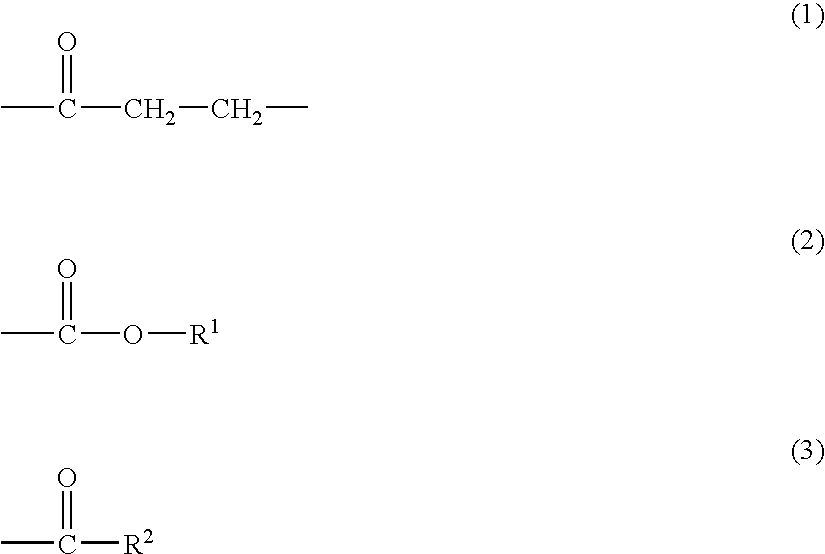Polyketone and process for producing the same
- Summary
- Abstract
- Description
- Claims
- Application Information
AI Technical Summary
Benefits of technology
Problems solved by technology
Method used
Image
Examples
example 1
25 micromoles of palladium acetate, 30 micromoles of 1,3-bis{di(2-methoxyphenyl)phosphino}propane, 1 millimole of sulfuric acid and 2.5 millimoles of 1,4-benzoquinone were dissolved in 40 ml of acetone to prepare a catalyst solution. This catalyst solution was introduced into a stainless steel autoclave of 2000 ml in capacity which contained 1000 ml of methanol-water mixed solvent (containing 12 vol % of water). Before the introduction of the catalyst, the methanol-water mixed solvent in the autoclave was previously subjected to nitrogen replacement three times at 30° C. and 3 MPa.
After the autoclave was closed, the content was heated while stirring, and when the internal temperature reached 85° C., ethylene was added until the internal pressure reached 4.5 MPa and subsequently carbon monoxide was added until the internal pressure reached 9.0 MPa. Thereafter, a mixed gas comprising 1:1 of ethylene and carbon monoxide was continuously fed and stirring was continued for 4 hours whi...
example 2
In 4 ml of acetone were dissolved 1.25 micromole of palladium acetate, 1.5 micromole of 1,3-bis(diphenylphosphino)propane and 50 micromoles of sulfuric acid, to obtain a catalyst solution. This was dissolved in 50 ml of a methanol / water mixed solvent containing 2000 ppm of water, and this solution was introduced into a stainless steel autoclave of 100 ml in capacity which was subjected to nitrogen replacement.
Thereafter, the temperature was raised to 80° C., and ethylene was introduced until the internal pressure reached 4.5 MPa and subsequently carbon monoxide was introduced until the internal pressure reached 9.0 MPa. Thereafter, a mixed gas comprising 1:1 of ethylene and carbon monoxide was continuously fed, and polymerization was carried out for 4 hours in the same formulation as in Example 1 while keeping the internal pressure at 9.0 MPa and the internal temperature at 85° C., thereby obtaining 1.33 g of a polyketone. The polymerization activity was 20.0 kg / g-Pd·hr, and the ...
example 3
The polymerization was carried out in the same manner as in Example 1, except that the composition of the catalyst solution comprised 10 micromoles of palladium acetate, 12 micromoles of 1,3-bis{di(2-methoxyphenyl)phosphino}propane, 1 millimole of sulfuric acid and 5.0 millimoles of 1,4-benzoquinone, and that the polymerization time was 10 hours, whereby 274 g of polyketone was obtained. The polymerization activity was 25.7 kg / g-Pd·hr, and the [η] was 6.3 dl / g. The content of Pd in this polyketone was 2 ppm, and the ratio of terminal group A / terminal group B was 2.0. This polyketone had good heat resistance.
PUM
| Property | Measurement | Unit |
|---|---|---|
| Temperature | aaaaa | aaaaa |
| Temperature | aaaaa | aaaaa |
| Temperature | aaaaa | aaaaa |
Abstract
Description
Claims
Application Information
 Login to View More
Login to View More - R&D
- Intellectual Property
- Life Sciences
- Materials
- Tech Scout
- Unparalleled Data Quality
- Higher Quality Content
- 60% Fewer Hallucinations
Browse by: Latest US Patents, China's latest patents, Technical Efficacy Thesaurus, Application Domain, Technology Topic, Popular Technical Reports.
© 2025 PatSnap. All rights reserved.Legal|Privacy policy|Modern Slavery Act Transparency Statement|Sitemap|About US| Contact US: help@patsnap.com



